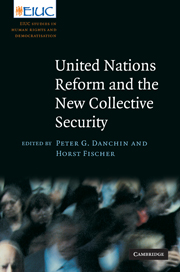Book contents
- Frontmatter
- Contents
- List of contributors
- Series editors' preface
- Preface
- List of abbreviations
- Introduction: the new collective security
- PART I Law and politics in United Nations reform
- PART II Defining “threats” to collective security
- PART III Prevention and responses
- PART IV Perspectives on the ground
- Bibliography
- Index
Introduction: the new collective security
Published online by Cambridge University Press: 05 May 2010
- Frontmatter
- Contents
- List of contributors
- Series editors' preface
- Preface
- List of abbreviations
- Introduction: the new collective security
- PART I Law and politics in United Nations reform
- PART II Defining “threats” to collective security
- PART III Prevention and responses
- PART IV Perspectives on the ground
- Bibliography
- Index
Summary
Whether viewed as a socio-legal project gently civilizing states away from an older politics of diplomacy, deterrence, self-help and legitimate warfare, or as an institutional project establishing a collective security system premised on the rule of law, the primary purpose of the United Nations today remains the maintenance of international peace and security and the abolition of the “scourge of war.” During the four long decades of the Cold War, the practice of the Security Council was shaped, and often thwarted, by superpower deadlock and the paralysis of veto. In nine major interstate uses of force between 1956 and 1982, the Council played only a marginal role. But with the ebbing of the Cold War in the late 1980s, and with a revitalized Council unanimously condemning Iraq's invasion of Kuwait in August 1990, the possibility of collective security arose anew.
The 1990s thus witnessed major shifts in multilateral efforts to maintain peace and security. Seemingly unnoticed, the permanent five began working together on major issues. The Security Council approved enforcement actions on a non-originalist interpretation of “threats to peace,” now read to include humanitarian considerations in principally internal conflicts. Following a modest record of authorizing force and employing sanctions, the Council greatly expanded its use of Chapter VII enforcement measures. And over the grave of the moribund Trusteeship Council, the UN resurrected a series of modern trusteeships in the form of transitional administrations.
- Type
- Chapter
- Information
- Publisher: Cambridge University PressPrint publication year: 2010



